Crown Fountain by Jaume Plensa
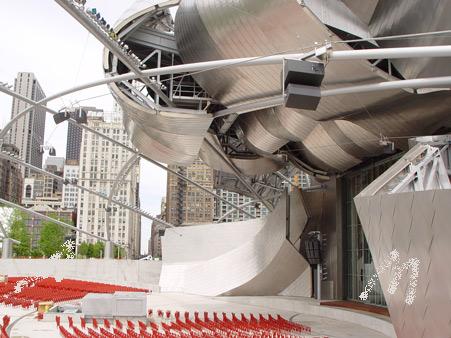
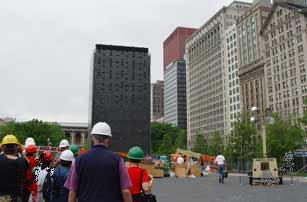
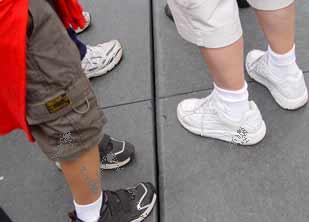
|
General Information about the Park
Crown Fountain by Jaume Plensa |

|
| For the past six years the city of Chicago has hosted the Annual Great Chicago Places and Spaces festival. Of the 175 tours available, there were two regarding Millennium Park, and I was able to get to both. So here is my recap of that weekend and some of the pictures I took, I say some because there were quite a few that I was unable to include. I don't want to overwhelm anyone. Above is a shot of the Pritzker Pavilion with most of the red chairs installed. By now I'm sure they should all be in place. |

|
| The tour began in the lobby of one of the buildings on Michigan Avenue, and from there we were given hard hats, and ushered to the park. When I saw the hard hats, I immediatly new it would be a different tour. I had initially thought the tour would just be around the construction site, and an explenation of the elements that make up the park. I'm glad it was way more than that. Our tour was conducted by the Millennium Park Director, Mr. Ed Uhlir. We started off right away at the Crown Fountain designed by Jaume Plensa of Barcelona. We got into the site, and learned that the floor is made of black granite. The picture below shows the crevice in which the water will drain to. That is the granite on the right side will have a shallow amount of water covering it, while the left side will remain dry. |

|
| The fountain will have a small opening in the lower part of both towers that will spout water. The water will in essence drench anyone that is caught under it, so I guess it will be Chicago's own free water "ride". A great way to cool down during the scorching summer heat. I wouldn't be suprised to see wet people walking up and down Michigan Avenue when this fountain is opened. Clad in special glass bricks, water will flow from the top over the facade and onto the granite surface below. The area will be accessible to people, because the artist wants everyone to interact with the piece, walk around barefoot, etc.. Below are some of the bricks before they were added on to the exterior. |

|
| The tour continued to the Bank One Promenade, and it was noted that the area will be clad in granite also, but not black granite. Below are some of the packages of granite that I believe will be used to finish off the promenade. I'm sure the granite will really make it look totally different than it does now with just concrete. The promenade will be open year round, and will be a gathering area for the park. Stretching the length of the park from north to south, the area may also get little tents selling art and other things. |
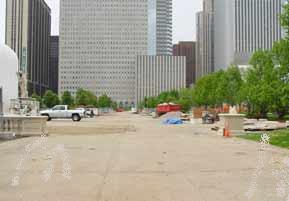
|
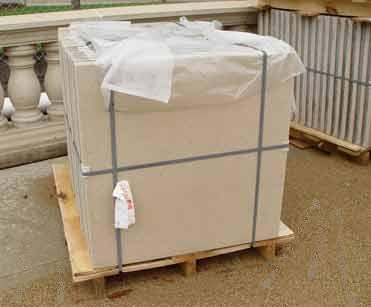
|
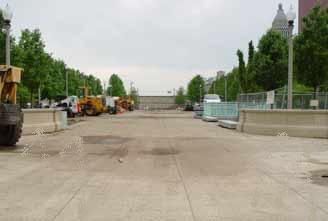 |
| As the tour progressed, we encountered light rain, so we headed into the shelter of the Kapoor Sculpture Tent. Unnamed, the sculpture has been kindly referred to as the “Bean” in reference to its kidney like shape. Anish Kapoor waits until his work is finished to name his art, and it will be interesting to see what he dubs this creation as. Outside of the tent were some pieces of the work that had not been attached. |
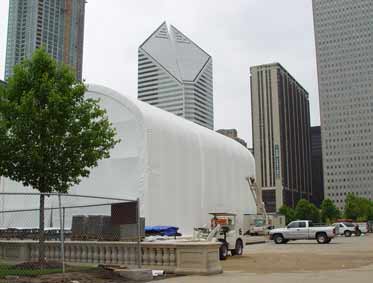
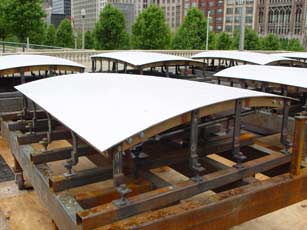
|
|
Kapoor had Precision Structures of Oakland California create his sculpture.
Assembled first in Oakland, all of the pieces had to then be disassembled and
sent to Chicago to be reassembled. This was a much easier way to send the piece
to Chicago than to put it on a barge as was originally proposed. Still, it would
have been interesting seeing this huge stainless steel work roll up into the
park. |
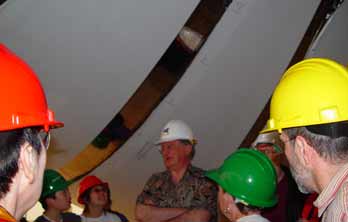
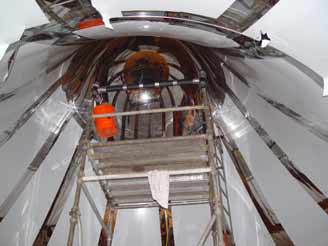
|
As we entered the tent it was evident that the immensity of the work was beyond what I had imagined. Standing under Kapoor’s work you notice just how massive it really is, and that is with only about a third of it complete when we visited. Underneath you see something very curious, as the sculptures projects inward almost, I’d guess, some 25 feet up. This spot will probably be well photographed by everyone who visits the site, because it will be polished so as to reflect everything around it. |
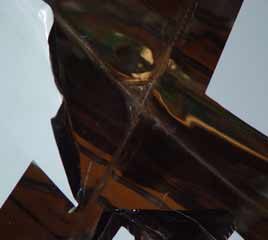
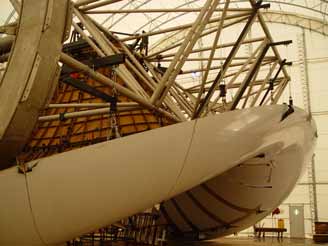
|
Mr. Uhlir commented that all the pieces have to be welded together and then be precisely polished in order to hide the seams. Reflecting the city and the lake, the work will definitely shed a different perspective on everything around it. On Chicago Tonight Mr. Uhlir mentioned that the steel is very thick so it will be hard to do real damage to it, in regards to vandalism. If it is scratched it can be buffed out. It would be a shame if anyone desecrated this work of art, but Chicago has many sculptures that haven’t and hopefully neither will this one. Kapoor’s work will continue Chicago’s legacy of large public art installations including works by Picasso, Chagall, DeBuffet and others, a work to usher in the new millennium no doubt. |
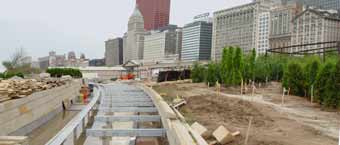
|
Moving on to the Lurie Garden, we find a site still very much in construction. For many this may be an overlooked part of the park, but when it’s done, I’m sure it will not go unnoticed. When the initial design of the park was unveiled in 1998, Blair Kamin remarked that the landscape left much to be desired. He felt the need for the park to provide a work that furthered the art of landscape design, and I think he and everyone will be greatly pleased with the design created by Kathryn Gustafson. |
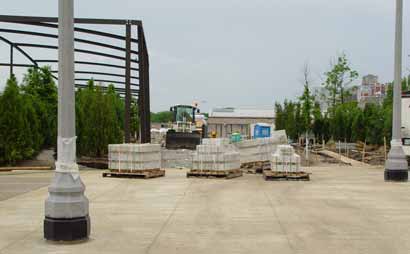 
|
Mr. Uhlir explained that the garden comes complete with a foot bridge that will traverse the garden diagonally, with running water underneath. Water features are interesting, especially in this urban setting. I believe the water is supposed to flow down from that “wall” on the left hand side, and underneath the bridge. I have found no rendering of this, but I do know a company that deals with fountains was consulted for the garden. |
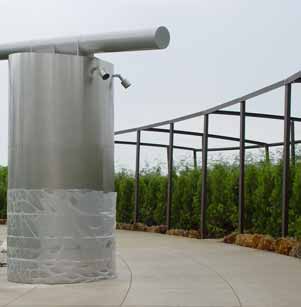 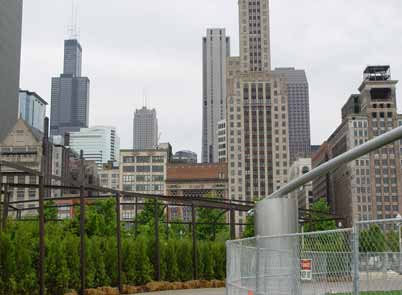
|
We were also told that the garden will have “Shoulder Hedges”
that will wrap around the south end of the trellis. In this manner, the
hedges will act as a buffer for the garden from the crowds exiting the
pavilion. We wouldn’t want all those perennials that Piet Oldolf
carefully selected to be damaged. I believe the hedges will grow into
the framework so as to provide a boxy shaped wall of green, and it may
take a couple years for them to mature. Even so, the frame doesn’t
look too out of place. |
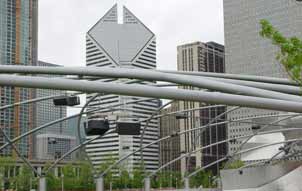
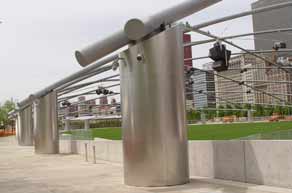
|
Working our way to the Pritzker Pavilion, we come upon the Gehry designed Trellis, that was inspired by the architects need to have the crowd not be cluttered by speaker poles. What we get then is a new way of listening to music outdoors, and is said to rival the sound provided in an indoor concert hall. I can’t wait to hear that. |
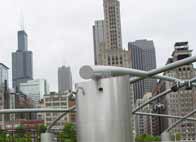
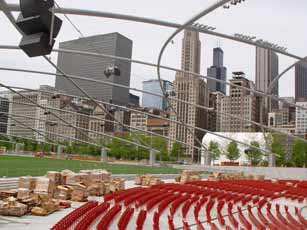
|
Another thing that is of interest is the way the trellis frames different aspects of our skyline. Sitting under this structure listening to music, while picnicking on a cool summer’s evening for a free concert will be the highlight of anyone’s visit to Chicago. |
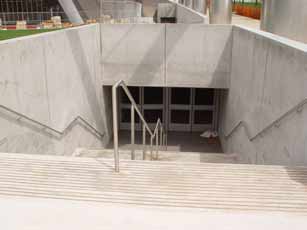
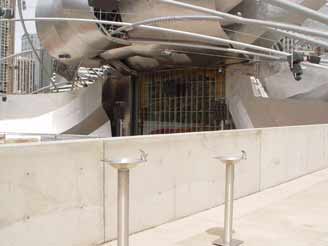
|
Attention to detail can be seen throughout the parks layout. Water fountains were even clad to fit in with the park’s décor, as were some fire hydrants. It was interesting to learn that the Pritzker Pavilion is not clad in titanium as is the Guggenheim Museum in Bilboa Spain, but is completely made up of titanium. This was because at the time titanium prices were relatively low, not so much now. The trellis is not titanium, but is painted to fit in with its surroundings, but I believe the pylons that hold up the trellis are clad in titanium also, because I know for sure they are concrete under all that. Also, I am not sure if those stairs lead down to the public restrooms, but I know for sure that the mayor did not want any portable toilets anywhere in the park. So low and behold we will have classy facilities here. I don’t have any pictures of them, but I know they can be found on the pbc site. |
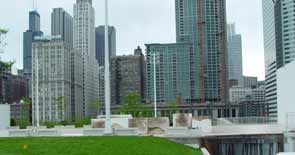
|
Now this next bit of information may be of quite some interest to future brides to be. It seems that this space pictured above, will have, sometime this summer, a tent capable of accommodating from 600-700 people for a sit down dinner. That’s right, this area will be rented out to the public for anything from private fund raising events, to lavish weddings. I’m not sure who you will have to contact about that, I’ll try to find that information, but I can see a three year waiting list already, just my prediction. Oh, and I believe Oprah is hosting the first Millennium Park wedding that will be given away to one of her viewers. Well she did donate a million dollars, so I guess she can use the facility at least once for free. |
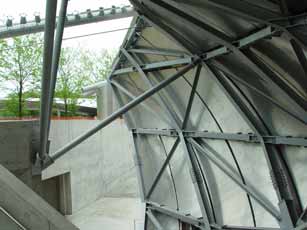
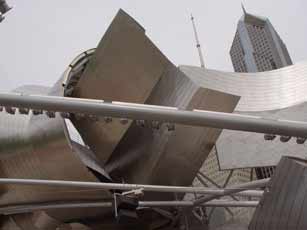
|
On to the Pavilion, and the amazing thing about this Gehry design is that it
is not a Gehry building, it is a work of art; something to be interacted with
by the masses, and enjoyed by all. A gift to the city indeed, and a way for
Chicago to continually sprint ahead, leaving its hog butcher legacy behind,
and embracing whatever new comes along. |
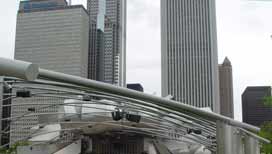
|
Chicago has done it time and time again, and will surely continue to do so in the future. Looking at this pavilion from any angle offers a new vantage point to the sculpture, because that is what it is. A very stylized sculpture surrounding a performance stage, a way to personify the music played there as larger than life. |
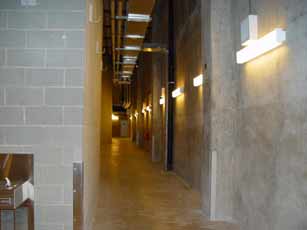
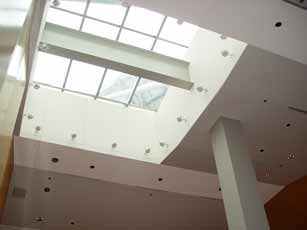
|
Clearly, once inside the pavilion, it can be noted that this building is not designed by Gehry, since it lacks the stylized flourishes that characterize the interiors of his buildings. Its inside is utilitarian; a get to work mentality pervades it, just like Chicago. Now, the one interior room that we visited before being ushered on stage was the rehearsal room behind the stage, which is clad in wood throughout and houses a wonderful skylight, with parts of the Gehry designed titanium “sails” evident. |

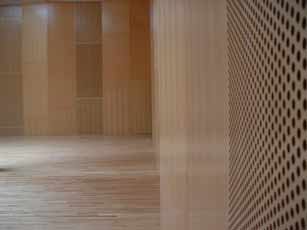
|
The rehearsal room is very bright, and an inviting space for musicians to practice before a big event. This room will also be available to rent out to the public for a variety of functions. Two areas to rent out in the park, I’m sure they will be very busy booking these spots when the park opens. The builders even thought far enough ahead to install a full functional kitchen, which they showed us, but I failed to take a picture of it. It lies behind the wall on the picture above on the right. The door slides open to reveal the kitchen, and is closed when not in use, so you wouldn’t even know that it was back there. |
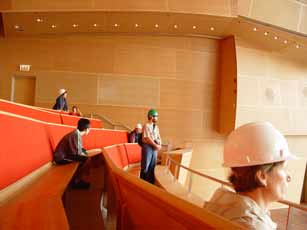
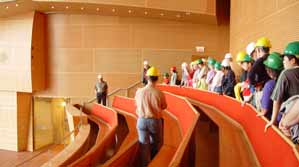
|
After viewing the rehearsal room, we were finally taken on stage to reveal in the immensity of the stage. We were taken to the rafter area where the chorus will sing as need be. What is most striking about the stage is all the wood, the Douglas fir used on the walls and the imported wood from Australia for the floor. The same type of wood used here is also found in Gehry’s interior of the Walt Disney Music Hall in Los Angeles. |
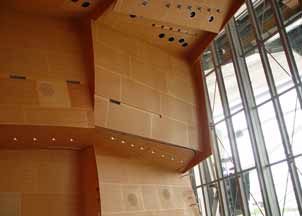 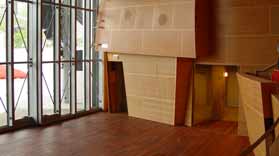
|
Mr. Uhlir also mentioned that the night before they had held a dinner on the stage for donors, and it seated 200 people. He mentioned that the glass doors that enclose the stage will help make sure that the space will be available to use year round. Therefore the stage may be rented out for private functions. So that would make three areas of the park accessible to rent, two of which would be available year round. |
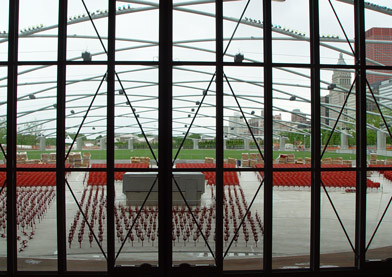
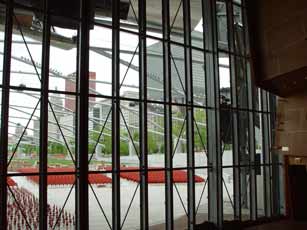
|
The glass doors are huge, and when asked Mr. Uhlir mentioned that they open in less than a minute. Looking out to the great lawn and the pavilion seating, the Grant Park Symphony Orchestra will have a great place to perform. The wood on the floor, jara wood, was selected because of its durability, and that it ages well in harsh weather. |
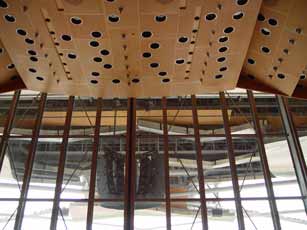 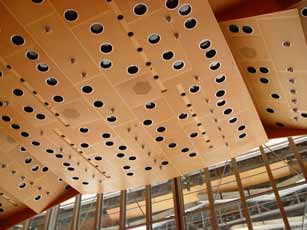
|
The ceiling is really interesting, full of stage lights embedded within. There are also hooks set up so if the need arises to set up banners or other things it will be suited to the task. The side walls of the stage have runners where curtains will cover the walls as a decorative touch. Overall I was very impressed with the space, and it would be fun to host an event in this room when it is not in use, especially in the winter, with snow everywhere but inside. |
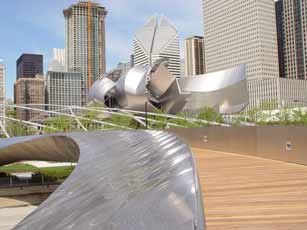 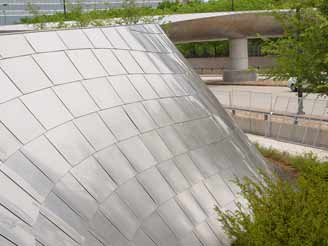
|
The final leg of the tour led us to the first Gehry designed bridge, the BP pedestrian bridge at that. An interesting feature is that it incorporates the Daley Bicentennial Park with Millennium Park, which was greatly needed, as this former part of Grant Park also seemed like the neglected step child of the parks system. I had forgotten all about it until I went to take some pictures of the park for this site. Hopefully now the under use of the Daley Park will be remedied. |
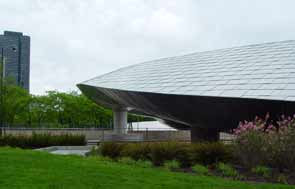
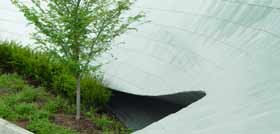
|
Designed in such a way as to provide a smooth transition over Columbus Drive, the bridge does exactly that and more. I had read somewhere that the bridge has a 5 degree incline. I can attest to the ease of which it takes to traverse it, you don’t even notice that you’re over the road until you hear the cars driving underneath you. |
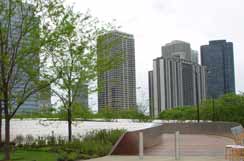
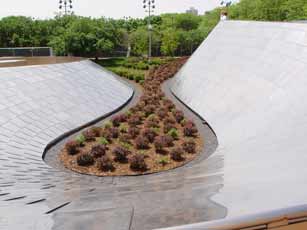
|
Originally they proposed to put a suspension bridge over the drive, but thought it would waste too much space. Gehry designed this bridge, and frankly it does a great job of winding over Columbus, while providing an interesting study in stainless steel bridge construction. From overhead you can really tell how well the bridge curves in and out, moving up and down depending on where you're standing. |
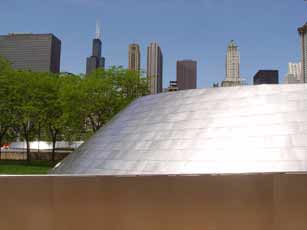
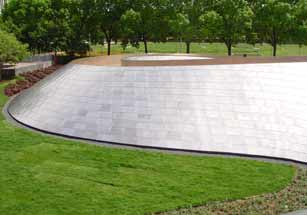
|
|
One thing of note is that the bridge is actually made to highway standards,
but that doesn’t mean it will have any vehicular traffic, what I would
like to see is the bridge at night, as there are slots on the side with lighting,
walking over it at night with the skyline behind it will really be another way
to enjoy Chicago. This is where the tour ended, we did not get into the Millennium
Monument, the Ice Rink, or the Park Grill. Those elements are open, so I’m
sure no one minded that they weren’t highlighted. I met a lot of people
on the tour that were just as excited about this project and the city as I am.
Hope that some of you have stumbled on to this page. This was a small recap
of the tour, and when it opens you too can take a free tour of the park, as
the Chicago Architecture Foundation will be on hand leading free docent lead
tours of the park. July 16 inaugural performance. |